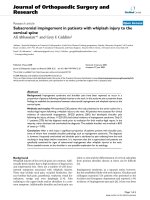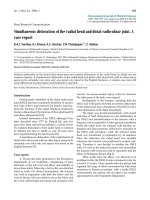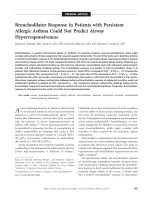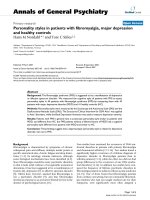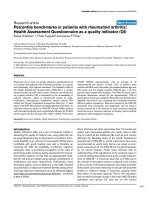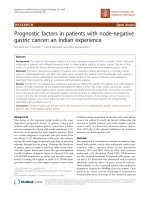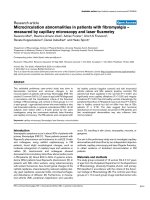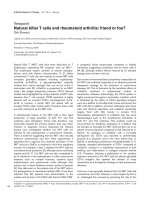Báo cáo y học: " Percentile benchmarks in patients with rheumatoid arthritis: Health Assessment Questionnaire as a quality indicator" pot
Bạn đang xem bản rút gọn của tài liệu. Xem và tải ngay bản đầy đủ của tài liệu tại đây (754.94 KB, 9 trang )
Open Access
Available online />R505
Vol 6 No 6
Research article
Percentile benchmarks in patients with rheumatoid arthritis:
Health Assessment Questionnaire as a quality indicator (QI)
Eswar Krishnan
1,2
, Peter Tugwell
3
and James F Fries
2
1
Clinical Research Center of Reading, West Reading, PA, USA
2
Division of Immunology and Rheumatology, Department of Medicine, Stanford University School of Medicine, Stanford, CA, USA
3
University of Ottawa, Ottawa, Canada
Corresponding author: Eswar Krishnan,
Received: 25 Mar 2004 Revisions requested: 30 Apr 2004 Revisions received: 6 Jun 2004 Accepted: 30 Jun 2004 Published: 14 Sep 2004
Arthritis Res Ther 2004, 6:R505-R513 (DOI 10.1186/ar1220)
http://arthr itis-research.com/conte nt/6/6/R505
© 2004 Krishnan et al.; licensee BioMed Central Ltd. This is an Open Access article: verbatim copying and redistribution of this article are permitted
in all media for any purpose, provided this notice is preserved along with the article's original URL.
Abstract
Physicians are in need of a simple objective, standardized tool
to compare their patients with rheumatoid arthritis, as a group
and individually, with national standards. The Disability Index of
the Health Assessment Questionnaire (HAQ-DI) is a simple,
robust tool that can fulfill these needs. However, use of this tool
as a quality indicator (QI) is hampered by the unavailability of
national reference values or benchmarks based on large,
multicentric, heterogenous longitudinal patient cohorts. We
utilized the 20-year longitudinal prospective data from 11 data
banks of Arthritis Rheumatism and Aging Medical Information to
calculate reference values for HAQ-DI. Overall, 6436 patients
with rheumatoid arthritis were longitudinally followed for 32,324
person-years over the 20 years from 1981 to 2000. There were
64,647 HAQ-DI measurements, with an average of 19
measurements per person. Overall, 75% of patients were
women and 89% were Caucasian; the median baseline age was
58.4 years and the median baseline HAQ-DI was 1.13. Few
patients were treated with biologics. The HAQ-DI values had a
Gaussian distribution except for the approximately 10% of
observations showing no disability. Percentile benchmarks allow
disability outcomes to be compared and contrasted between
different patient populations. Reference values for the HAQ-DI,
presented here numerically and graphically, can be used in
clinical practice as a QI measure to track functional disability
outcomes and to measure response to therapy, and by arthritis
patients in self-management programs.
Keywords: benchmark, disability, Health Assessment Questionnaire, percentile, rheumatoid arthritis
Introduction
Quality indicators (QIs) are a set of measures helpful in
assessing the quality of medical care, using data that can
be easily obtained in day-to-day practice of medicine. Func-
tional disability is an outcome in rheumatoid arthritis that is
modifiable with good medical care and is therefore an
important QI. With the availability of effective treatment
strategies, there is increasing recognition of the value of
performing audits involving quality assessment for rheuma-
toid arthritis patients, so that they are appropriately strati-
fied for risk and are treated using optimal combinations of
medications and other interventions. Furthermore, many
third-party payers, such as Medicare in the USA, demand
documentation of objective treatment benefit among those
receiving expensive medications such as infliximab (http://
www.hgsa.com/professionals/policy/i20d.html, accessed
9 March 2004).
Since clinicians can often spend less than 15 minutes per
patient with rheumatoid arthritis per month, there is little
time to collect all the traditional QIs such as joint counts.
Although the Disability Index of the Health Assessment
Questionnaire (HAQ-DI) or similar instruments have been
recommended as useful tools that are as robust as com-
posite measures [1,2], the HAQ-DI has not gained popular-
ity, for various reasons. Firstly, many clinicians lack an
understanding of the significance of its numerical value. In
a clinical setting, the questionnaire gives a single measure-
ment of HAQ-DI – a numerical value that is of little use to
the clinician or the patient unless it is placed in the context
of the universe of rheumatoid patients. Secondly, the HAQ-
DI has been used most extensively in clinical trials and other
studies to measure change in functional capacity rather
than status of functional capacity. That is, the discussion
has focused on average change in the mean HAQ-DI within
individuals and groups [3] and not on the clinical
HAQ-DI = Disability Index of the Health Assessment Questionnaire; QI = quality indicator.
Arthritis Research & Therapy Vol 6 No 6 Krishnan et al.
R506
significance of a change in the numerical value of the HAQ-
DI in a real-world situation.
The underlying problem for both of these issues is the
absence of standards or benchmarks for the HAQ-DI. As
an example, there are benchmarks for height and weight
progression with age in children (commonly known as
growth charts). Typically, such a chart would include the
reference median and the 10th, 25th, 75th, and 90th per-
centiles of height and weight as a function of age, with sep-
arate charts for boys and girls. Children being followed up
over time have their height and weight taken and plotted on
the growth charts. This provides visual information on how
the child is doing compared with others, as well as how the
child's height and weight have been increasing over time. If
the growth curve flattens out, that is an early indicator of a
potential problem and triggers further evaluation. For track-
ing disability over time, it would be very useful for clinicians
to have similar 'disability growth curves'. It would help to
place individual disability index measurements in the con-
text of a wider population with rheumatoid arthritis as well
as to track disability over time. In addition, the group mean
and median HAQ-DI will help educate the clinician about
how well his/her patients are doing compared with those
outside the practice and will serve as an important QI for
rheumatoid arthritis care.
Development of such progress charts of disability would
ideally require longitudinal data from a large, nationally rep-
resentative sample of patients with rheumatoid arthritis. As
such data are not available in the USA, the next-best data
set would be drawn from multiple centers across the coun-
try involving a large number of HAQ disability measure-
ments and involving all stages of disease and a
demographically broad sample. Prospective rather than
cross-sectional measurements have important advantages,
in guarding against cohort bias (differences between age
groups in a cross-sectional study that are due to genera-
tional differences rather than to age per se). The longitudi-
nal data sets from the Arthritis, Rheumatism and Aging
Medical Information System (ARAMIS) cohorts of patients
with rheumatoid arthritis fulfill these requirements.
Materials and methods
Patients
The subjects for the present study were derived from the
Arthritis, Rheumatism and Aging Medical Information Sys-
tem, a US national arthritis data resource based at Stanford
University. This system includes multiple data-bank centers
in the United States and Canada and follows about 17,000
patients with specific arthritis conditions as well as normal
populations of aging seniors [4,5]. As a part of this pro-
gram, 6436 patients with rheumatoid arthritis have been
enrolled and their functional disability has been regularly
assessed with mailed HAQs. The disability data used in this
report include those collected from 11 diverse data banks
in 8 centers across the United States and Canada. These
centers served consecutive patients from two private rheu-
matology practices, two geographically defined communi-
ties, and four university clinics. Patients were entered into
the cohort by their clinicians in the respective centers or by
direct advertising in particular centers [6]. All patients had
a diagnosis of rheumatoid arthritis as defined by the 1958
American Rheumatism Association [7] or the 1987 Ameri-
can College of Rheumatology classification criteria [8],
depending on time of enrollment.
Instrument
After giving informed consent, each patient completes a full
HAQ at the time of entering the study and every six months
thereafter. Consecutive patients enrolled through the year
2000 were followed with semiannual Health Assessment
Questionnaires that included the HAQ-DI consistently from
its introduction in 1980 [9]. The Health Assessment Ques-
tionnaire (HAQ) is a widely used and validated tool to quan-
tify self-reported functional disability in rheumatoid arthritis
[10]. The questionnaire is usually self-administered but may
also be completed face-to-face in a clinical setting or in a
telephone interview format by trained outcome assessors.
Eight functional categories are assessed specifically by the
HAQ: dressing and grooming, arising, eating, walking,
hygiene, reach, grip, and common daily activities. For each
of these domains, patients report the amount of difficulty
they have had in performing two to three specific activities
in the previous week. Patients usually find items in the HAQ
easy to understand and the questions are entirely self-
explanatory. If a question within a domain does not apply
(e.g. if an individual doesn't shampoo the hair or take tub
baths), then the item is left blank. There are four possible
responses and corresponding scores for each question:
without any difficulty (score = 0), with some difficulty (1),
with much difficulty (2), and unable to do (3). The highest
score reported by the patient for any component question
in each domain determines the score for that domain. A
complete copy of the instrument and coding rules can be
downloaded from
. The data col-
lection and quality control protocols have been described
in detail [4,5,10].
Scoring and interpreting the HAQ-DI
By convention, the Disability Index is expressed on a scale
from 0–3 units, representing the mean of the eight domain
scores. A HAQ-DI of 0 indicates no functional disability,
while a Disability Index of 3 indicates severe functional dis-
ability. A healthy individual is expected to have a HAQ-DI of
0. While there is no official consensus as to what consti-
tutes mild, moderate, or severe disability, a score of ≤ 1.0 is
regarded as indicating mild disability, and a score ≥ 2.0 is
considered to indicate severe disability. The Disability Index
values in between can be considered moderate.
Available online />R507
Statistics
The 10th, 25th, 50th, 75th, and 90th percentiles were used
as reasonable benchmarks for the computation of data for
various strata of age, sex, and disease duration. For plotting
the smoothed growth curves, we used cubic splines. For
calculating the 95% confidence bands, we fitted fractional
polynomial regression. In this method, the disability is
regressed as a function of disease duration modified to var-
ious powers and the best fit achieved by an iterative
process.
Median values of HAQ-DI across groups were compared
using the nonparametric median test [11]. In each test, the
hypothesis K-samples were drawn from the population of
the same median. The test χ
2
statistic was calculated with
and without a continuity correction (reference median).
Correlation between age, disease duration, and HAQ-DI
was calculated using Pearson's correlation coefficient (r).
Comparison with nondiseased population
To better appreciate the differences in the distribution of
the HAQ-DI in patients with rheumatoid arthritis compared
with that in nondiseased populations and to benchmark
disability in these populations, we used data from two other
longitudinal studies going on in our center: the University of
Pennsylvania Alumni study [12] and Stanford University
Staff used as controls in the Stanford Runners study [13].
The University of Pennsylvania Alumni study comprised
23,414 Disability Index measurements in 2843 alumni
(77% men), and there were 587 controls (56% men) in the
runners study, observed through 5751 Disability Index
measurements. Age-specific median curves from these
subjects are presented alongside those from patients with
rheumatoid arthritis as illustrations and not as scientific
comparisons, since the population denominator for these
data is much different from that of patients with rheumatoid
arthritis.
Results
Baseline characteristics
Table 1 gives the baseline descriptive statistics of our pop-
ulation of patients. Overall, there were 6436 patients (4768
[74%] of them women), and there were 64,647 observa-
tions. The median age was 58.5 years, the median disease
duration at baseline was 8.0 years, and the median base-
line HAQ-DI was 1.13. The mean (standard deviation)
baseline HAQ-DI was 1.18 (0.79) units. The median test
showed that the women studied were younger (P < 0.001),
more disabled (P < 0.001), and less educated (P = 0.038)
than the men. The overall attrition rate of the cohort was 3.8
per 100 living patients per annum [14].
Follow-up data
The number of observations per patient ranged from 1 to
38 (median 7, interquartile range 3–15). The median time
between successive questionnaires was 184 days (inter-
quartile range 172–198 days). Overall, in about 9.9% of all
observations the HAQ-DI was recorded as 0. Figure 1
shows the distributional plot of all 64,647 HAQ-DI meas-
urements. Aside from a spike representing about 10% of
observations for which the HAQ-DI = 0 (n = 1423, N =
6307), the distribution of the Disability Index values in the
study population was Gaussian. The mean (standard devi-
ation) overall HAQ-DI was 1.27 (0.82). Interestingly, 249
patients (4%) had no disability at all revealed in any of their
observations.
Table 1
Baseline characteristics of 6436 patients with rheumatoid arthritis observed for 32,324 person-years with semiannual Health
Assessment Questionnaires
Patients Age (years) Level of
education
(years)
Disease
duration (years)
Number of
HAQ-DI
measurements
HAQ-DI Patients
receiving
methotrexate
Patients
receiving
prednisone
Women 21.2% 23.7%
Median 57.3 12.0 8.1 7 1.25
IQR 46.8–67.0 12.0–14.0 2.4–16.7 4–14 0.63–1.88
Men 18.5% 23.9%
Median 61.0 12.0 7.4 7 1.00
IQR 51.4–69.0 11.0–14.0 2.0–16.6 3–12 0.25–1.50
All patients 20.5% 23.8%
Median 58.5 12.0 8.0 7 1.13
IQR 48.0–67.4 12.0–14.0 2.3–16.7 4–13 0.5–1.8
HAQ-DI, Health Assessment Questionnaire Disability Index (range 0–3); IQR, interquartile range.
Arthritis Research & Therapy Vol 6 No 6 Krishnan et al.
R508
Percentiles of HAQ-DI values are reported, according to
patient's age and duration of disease, for women (Table 2)
and men (Table 3). HAQ-DI increased with age in both men
and women. Women had slightly higher levels of functional
disability than men. The HAQ-DI was only modestly corre-
lated with disease (correlation coefficient 0.28; 95% confi-
dence interval 0.28–0.29). The corresponding correlation
coefficients for men and women were 0.30 (0.29–0.32)
and 0.28 (0.27–0.29), respectively.
The curves showing overall duration versus HAQ-DI, with
95% confidence bands (fitted using fractional polynomial
modification of ordinary least squares regression), are
shown in Fig. 2. Figures 3 and 4 show the percentile curves
of HAQ-DI as a function of disease duration in strata of age
and sex.
In order to visualize the relation between age and disability,
we plotted the age-specific median HAQ-DI (Fig. 5). Age-
related increases were less marked than duration-related
increases. The correlation coefficients for age and HAQ-DI
among patients with rheumatoid arthritis were 0.20 (0.18–
0.22) for men and 0.17 (0.16–0.18) for women. In
comparison with the University of Pennsylvania Alumni
study and population controls used in the Stanford Run-
ners study, the percentile values were substantially higher
in younger age groups. However, as age advanced, the dis-
ability gap between the rheumatoid arthritis and compara-
tor populations narrowed. Detailed percentile curves for
each age and for subgroups according to sex are given in
the Additional files (Figs 6–18).
Discussion
Disability outcomes in rheumatoid arthritis have indeed
improved in the past 20 years, in parallel with the availability
of better treatments [15,16], even though a number of
patients continue to suffer substantial functional limitations
[15,16]. The idea of benchmarking functional disability
among populations using the Health Assessment Ques-
tionnaire is not new. To our knowledge, the idea of bench-
marking using the HAQ-DI in clinical practice was first put
forward by Marissa Lassere and her colleagues in 1995
[17]. The main limitation in their report was small sample
size and the cross-sectional nature of the analysis. Subse-
quently, Wolfe and colleagues published benchmarks on
the HAQ-DI in addition to other variables such as tender
and swollen joint counts [18]. While their sample size was
much larger than that of Lassere and colleagues, the data
presented were cross-sectional in nature. The median
(IQR) HAQ-DI for that group of patients with rheumatoid
arthritis was 0.6 (0.2–1.3). In none of these reports were
disease-duration-specific values or curves provided, mak-
ing it difficult to use their suggested benchmarks in a longi-
tudinal fashion or to compare them directly with our results.
In this report, we have carried forward the idea of disability
as a QI among patients with rheumatoid arthritis, while
attempting to overcome some of the limitations of the pre-
vious work.
Strengths
The data we have presented are based on a large number
of disability measurements drawn from a wide variety of
clinical settings including the community, university set-
tings, and private practices, prospectively collected, and
encompassing a long period. We have presented disability
reference values for all strata of disease duration and age
groups and for both sexes. Our results are consistent with
the previously published data. We believe that our bench-
marks represent an advance over the existing data and pro-
pose that they be considered for day-to-day use in clinical
practice.
How to use the data presented
Disability 'growth curves'
We have provided percentile values as well as a percentile
growth curve similar to growth curves that can be easily vis-
ualized and interpreted by physicians who are already famil-
iar with the concept of growth charts. These data also help
the clinician to place his or her individual patient in compar-
ison with the nationally available data. It also enables prac-
tices to compare the functional disability of their own
patients with the national cohorts and to track disability
through time. Nurses and allied health professionals can
use this to direct special attention to those who are not
doing well in follow-up. Furthermore, patients themselves
are likely to find the percentile charts an important tool for
Figure 1
Distribution of scores on the Health Assessment Questionnaire (HAQ) Disability Index in 6436 patients (64,647 observations) with rheumatoid arthritisDistribution of scores on the Health Assessment Questionnaire (HAQ)
Disability Index in 6436 patients (64,647 observations) with rheumatoid
arthritis.
Available online />R509
self-management. Overall, our study will be helpful in estab-
lishing useful benchmarks of QI in North America.
Z-scores for disability
Another way to use the data we have presented would be
to calculate Z-scores for the HAQ-DI similar to the method
of standardizing bone mineral density. The Z-score for an
item indicates how far and in what direction that item devi-
ates from the mean of its distribution, expressed in units of
the distribution's standard deviation. The mathematics of
the Z-score transformation is such that if every item in a dis-
tribution is converted to its Z-score, the transformed scores
will have a mean of 0 and a standard deviation of 1. Z-
scores are sometimes called 'standard scores'. The Z-
score transformation is especially useful when there is a
need to compare the relative standings of items from distri-
butions with different means and/or different standard devi-
ation. The Z-scores for patients with rheumatoid arthritis
can be calculated by using an age- and sex-matched distri-
bution of the HAQ-DI. Individual Z-scores can then be used
to assess the relative progress of individual patients and to
establish reasonable therapeutic end points. Caution must
be exercised in doing so, because these metrics assume a
Gaussian distribution of HAQ-DI (i.e. a bell curve), an
assumption that may not be accurate in all situations.
Table 2
Percentile values of semiannual scores on the Health Assessment Questionnaire Disability Index found for 4768 women with
rheumatoid arthritis observed for for 50,047 person-years
Disease duration (years)
Age group
(years)
Percentile <2 2–3.9 4–5.9 6–7.9 10–11.9 12–13.9 14–15.9 16–17.9 18–19.9
<50 100000000.12500
25 0.25 0.25 0.375 0.375 0.5 0.5 0.625 0.5 0.625
50 0.875 0.75 0.875 0.875 1.125 1.125 1.125 1.25 1.25
75 1.375 1.375 1.375 1.5 1.625 1.625 1.625 1.75 1.875
90 1.75 1.75 1.875 1.875 2 2 2.125 2.125 2.25
95 2.125 2.125 2.125 2.25 2.25 2.25 2.375 2.375 2.5
50–59.9 10 0 0 0.125 0.25 0.125 0.125 0 0 0.125
25 0.375 0.375 0.625 0.625 0.625 0.5 0.5 0.5 0.75
50 1 1 1.125 1.25 1.125 1.1875 1.125 1.25 1.375
75 1.5 1.5 1.75 1.75 1.75 1.75 1.75 1.875 2
90 1.875 2 2.125 2.25 2.25 2.25 2.125 2.25 2.375
95 2.125 2.125 2.375 2.375 2.375 2.375 2.5 2.5 2.625
60–69.9 10 0 0 0 0.25 0.125 0.25 0.25 0.375 0.375
25 0.25 0.25 0.5 0.75 0.75 0.75 0.75 0.75 1
50 0.75 0.875 1.125 1.25 1.375 1.5 1.5 1.5 1.625
751.251.51.751.87522222.125
90 1.875 2 2.125 2.25 2.375 2.375 2.5 2.375 2.625
95 2.125 2.25 2.375 2.5 2.5 2.625 2.625 2.625 2.875
≥ 70 10 0.125 0.125 0.125 0.125 0.25 0.375 0.375 0.375 0.625
25 0.5 0.5 0.5 0.625 0.875 1 1 1.125 1.25
50 1 1.125 1.125 1.25 1.5 1.625 1.75 1.75 1.875
75 1.625 1.625 1.75 1.875 2 2.125 2.25 2.375 2.375
90 2.125 2.125 2.375 2.375 2.375 2.5 2.625 2.75 2.75
95 2.375 2.5 2.625 2.625 2.625 2.75 2.75 2.875 2.875
Arthritis Research & Therapy Vol 6 No 6 Krishnan et al.
R510
Disability as a dichotomous entity
Yet another way to use our data would be to define disabil-
ity as an (artificially) dichotomous entity, for example HAQ-
DI ≥ 1. Here the age- and sex-specific prevalence rates of
disability in our population could be applied to the clinical
samples to derive the expected number of disabled
patients. The ratio of the observed to the expected number
of patients with an HAQ-DI greater than a threshold value
can serve as a standardized 'morbidity ratio' of that
particular patient population. Using this method, Sokka and
colleagues compared the HAQ-DIs of rheumatoid arthritis
patients with those of the underlying general population in
Finland and found an eightfold higher prevalence of disabil-
ity among patients with rheumatoid arthritis [16]. One could
also potentially calculate and compare the costs and could
cost utility measures such as disability-adjusted life years
(DALYs) across populations. Benchmarks for the HAQ-DI
in a general population are also available for such compu-
tations [19].
Using benchmarks in the office
There are several ways to apply the information we have
provided, in both clinical practice and observational stud-
ies. We recommend that the choice of method be dictated
by the nature of the data at hand and the application in
question. The benchmarks we have discussed represent
relative standards to be used for comparisons only. We
certainly do not suggest that any particular value for HAQ-
Table 3
Percentile values of semiannual scores on the Health Assessment Questionnaire Disability Index (HAQ-DI) found for 1668 men with
rheumatoid arthritis observed for 14,600 person-years
Disease duration (years)
Age group
(years)
Percentile <2 2–3.9 4–5.9 6–7.9 10–11.9 12–13.9 14–15.9 16–17.9 18–19.9
<50 10000000000
25 0.375 0.375 0.5 0.375 0.375 0.25 0.375 0.375 0.625
50 0.75 0.8125 1 1 0.875 0.75 0.875 0.875 0.9375
75 1.125 1.375 1.5 1.375 1.5 1.5 1.625 1.625 1.5
901.752222221.8751.875
95 2 2.375 2.125 2.25 2.375 2.25 2.125 2.25 2
50–59.9 10 000000000
25 0.5 0.4375 0.5 0.625 0.625 0.75 0.6875 0.875 0.75
50 1 0.875 1 1 1.125 1.125 1.125 1.375 1.375
75 1.375 1.375 1.5 1.5 1.625 1.75 1.625 2.125 1.75
90 1.75 1.75 2 1.875 2 2.125 2.25 2.375 2.25
95 2 2 2.25 2.125 2.5 2.5 2.5 2.625 2.5
60–69.9 10 00000.1250.1250.1250.1250
25 0.375 0.4285 0.625 0.625 0.75 0.625 0.75 0.75 0.75
50 0.875 0.875 1.125 1.25 1.125 1.125 1.25 1.25 1.375
75 1.25 1.375 1.625 1.625 1.625 1.75 1.75 1.75 1.9375
90 1.5 1.75 2 2.125 2 2.125 2.125 2.25 2.375
95 1.75 2 2.25 2.375 2.25 2.375 2.5 2.5 2.5
≥ 70 100000000.1250.1250.25
25 0.375 0.375 0.625 0.75 0.875 0.5 0.625 0.625 0.9375
50 0.875 0.875 1 1.25 1.375 1.125 1.25 1.25 1.5
75 1.25 1.25 1.375 1.625 1.75 1.625 1.875 1.875 2
90 2 1.625 1.875 2.125 2.375 2.125 2.25 2.5 2.5
95 2.125 2 2.125 2.375 2.5 2.25 2.5 2.625 2.75
Available online />R511
DI greater than 0 is 'normal' or desirable for an individual
patient. In fact, an argument for using the absolute bench-
mark for functional disability – i.e. HAQ-DI > 0 – can be
made, since the goal of treating an individual patient is to
ameliorate disease activity and entirely prevent joint dam-
age. However, even the most optimistic randomized, con-
trolled trials of biologic agents indicate that such an
expectation may not yet be realistic for most individuals.
Until a remission-inducing agent is available, the use of an
HAQ-DI = 0 as an absolute benchmark may not be practi-
cal in most clinical situations. Furthermore, the HAQ-DI is
one of several yardsticks for measuring functional disability,
and an HAQ-DI = 0 does not guarantee that a person is
fully functional.
Minimum significant change
There are no studies that have answered the question:
what is the clinically meaningful change in HAQ-DI in an
average patient with rheumatoid arthritis and in a patient
group in a rheumatology practice? The available literatures
have been based on a posteriori analyses of data from
randomized, controlled trials and small, qualitative research
studies, and as such are not generalizable to real-world
medicine [20,21]. Patients with rheumatoid arthritis are
known to have day-to-day fluctuations of the HAQ-DI, and
these have not been well studied. Thus, changes in the
HAQ-DI within individual patients are sometimes difficult to
distinguish from the underlying 'noise'. Our recommenda-
tions to overcome this noise are to use these benchmarks
on individual patients with caution; to use an average of 2–
3 consecutive HAQ-DI measurements rather than a single
one; and to use other easily obtained measures, such as
pain or physician's and patient's global assessments, in
conjunction with the HAQ-DI.
Other significant findings in these data
In addition to providing points of reference for functional
disability, some other observations regarding these data
merit discussion. Rheumatoid arthritis is a disease whose
activity varies with time. The HAQ-DI accurately tracks the
fluctuating disease activity even in long-standing rheuma-
toid arthritis [22]. Our finding that about 10% of all obser-
vations had an HAQ-DI of 0 reflects this heterogeneity in
disease activity within and across patients, and not a 'floor
effect'.
Figure 2
Percentile Health Assessment Questionnaire (HAQ) Disability Index scores plotted against disease duration for 6436 patients (64,647 observations) with rheumatoid arthritis, with 95% confidence bandPercentile Health Assessment Questionnaire (HAQ) Disability Index
scores plotted against disease duration for 6436 patients (64,647
observations) with rheumatoid arthritis, with 95% confidence band.
Figure 3
Percentile Health Assessment Questionnaire (HAQ) Disability Index scores plotted against disease duration for 1668 men with rheumatoid arthritis followed with 14,600 observationsPercentile Health Assessment Questionnaire (HAQ) Disability Index
scores plotted against disease duration for 1668 men with rheumatoid
arthritis followed with 14,600 observations.
Arthritis Research & Therapy Vol 6 No 6 Krishnan et al.
R512
The concern in studying the progression of functional disa-
bility in longitudinal studies is the potential confounding by
age-associated changes. Our observation that disease
duration is a stronger correlate of the HAQ-DI than age
suggests that as patients are followed up over time, an
increase in disability is more from the disease process and
the damage it inflicts than from age or age-related disability.
In a comparison with two diverse nondiseased populations,
we found that there was little excess disability in older
patients (>60 years) with rheumatoid arthritis. Among
younger age groups, the excess disability was substantial.
These findings are in line with those from a population-
based study from Finland [16].
Limitations of the present study
Caveats apply to our results. Ideally, benchmarks should be
obtained from a nationally representative sample of patients
with rheumatoid arthritis: our patient group was not such a
sample. However, as such a national sample is not availa-
ble, the next-best data would be from large, longitudinal
data banks with long follow-up, such as ours. We did have
information on racial minorities, but these were few, dispa-
rate, scattered, and divided among different subsets. While
large observational studies like ours tend to have the prob-
lem of volunteer bias, our attrition rates were very small.
Patients in this cohort have been treated with various dis-
ease-modifying antirheumatic drugs according to various
regimens (differing in drug potency and dosage and in
duration of treatment). Furthermore, none of our patients
had been exposed to biologics, a class of medications
whose effect on long-term functional disability can be
expected to be substantial. In the future our benchmark
curves may be replaced by population benchmarks of func-
tional disability [19]; until such a time, our benchmarks will
prove useful.
Conclusion
Short of full restoration of the premorbid functional capac-
ity, the objective of treatment in rheumatoid arthritis should
be to minimize disability. Comparison of patients and
patient groups across different practice settings requires
standards or benchmarks for disability outcomes, such as
the HAQ-DI. We have provided age-specific, sex-specific,
and disease-duration-specific percentile values for the
HAQ-DI in numerical and graphical forms and this informa-
tion can be used for following individual patients, as a QI,
and as a tool for self-management. We also report that dis-
ease duration is a stronger correlate of functional disability,
independent of the concomitant increase in age and age-
related comorbidities.
Competing interests
None declared.
Figure 4
Percentile Health Assessment Questionnaire (HAQ) Disability Index curves plotted for 4768 women with rheumatoid arthritis with 50,047 observationsPercentile Health Assessment Questionnaire (HAQ) Disability Index
curves plotted for 4768 women with rheumatoid arthritis with 50,047
observations.
Figure 5
Age-related changes in median Health Assessment Questionnaire Dis-ability Index (HAQ-DI) in 64,647 observations in 6436 patients with rheumatoid arthritis compared with 5751 observations in 587 nondis-eased controls of the Stanford Runners study and 23,414 observations in 2843 subjects in the University of Pennsylvania Alumni studyAge-related changes in median Health Assessment Questionnaire Dis-
ability Index (HAQ-DI) in 64,647 observations in 6436 patients with
rheumatoid arthritis compared with 5751 observations in 587 nondis-
eased controls of the Stanford Runners study and 23,414 observations
in 2843 subjects in the University of Pennsylvania Alumni study.
Available online />R513
Additional files
Acknowledgments
The authors thank Jane Crosby and Eliza Chakravarty for critical com-
ments. This work was supported by a grant from the National Institutes
of Health to Arthritis, Rheumatism and Aging Medical Information Sys-
tem (AR 43584).
References
1. Wolfe F, Pincus T: Data collection in the clinic. Rheum Dis Clin
North Am 1995, 21:321-358.
2. Wolfe F, Pincus T, Fries JF: Usefulness of the HAQ in the clinic
[letter]. Ann Rheum Dis 2001, 60:811.
3. Wiles NJ, Scott DG, Barrett EM, Merry P, Arie E, Gaffney K, Silman
AJ, Symmons DP: Benchmarking: the five year outcome of
rheumatoid arthritis assessed using a pain score, the Health
Assessment Questionnaire, and the Short Form-36 (SF-36) in
a community and a clinic based sample. Ann Rheum Dis 2001,
60:956-961.
4. Krishnan E, Fries JF: Reduction in long-term functional disability
in rheumatoid arthritis from 1977 to 1998: a longitudinal study
of 3035 patients. Am J Med 2003, 115:371-376.
5. Singh G: Arthritis, Rheumatism and Aging Medical Information
System Post-Marketing Surveillance Program. J Rheumatol
2001, 28:1174-1179.
6. Krishnan E, Singh G, Tugwell P: Long-term observational stud-
ies. In Targeted Therapies in Rheumatology Edited by: Smolen J,
Lipsky P. London: Martin Dunitz; 2003:667-677.
7. Ropes MB, Bennett GA, Cobb S, Jacox R, Jessar RA: 1958 Revi-
sion of diagnostic criteria for rheumatoid arthritis. Bull Rheum
Dis 1958, 9:175-176.
8. Arnett FC, Edworthy SM, Bloch DA, McShane DJ, Fries JF, Cooper
NS, Healey LA, Kaplan SR, Liang MH, Luthra HS, et al.: The Amer-
ican Rheumatism Association 1987 revised criteria for the
classification of rheumatoid arthritis. Arthritis Rheum 1988,
31:315-324.
9. Fries JF, Spitz P, Kraines RG, Holman HR: Measurement of
patient outcome in arthritis. Arthritis Rheum 1980, 23:137-145.
10. Bruce B, Fries JF: The Stanford Health Assessment Question-
naire: a review of its history, issues, progress, and
documentation. J Rheumatol 2003, 30:167-178.
11. Statacorp: Median. In Stata Reference Manual Volume 3. 7.0th
edition. College Station, TX: Stata Press; 1999:424-431.
12. Fries JF, Williams CA, Morfeld D: Improvement in intergenera-
tional health. Am J Public Health 1992, 82:109-112.
13. Lane NE, Bloch DA, Jones HH, Marshall WH Jr, Wood PD, Fries
JF: Long-distance running, bone density, and osteoarthritis.
JAMA 1986, 255:1147-1151.
14. Krishnan E, Murtagh K, Bruce B, Cline D, Singh G, Fries J: Attrition
bias in rheumatoid arthritis databanks: A case study of 6346
patients in 11 databanks and 65,649 administrations of the
Health Assessment Questionnaire. J Rheum in press.
15. Krishnan E, Fries JF: Time trends in cumulative disability in
rheumatoid arthritis 1980–1998 [abstract]. Arthritis Rheum
2002, 44:378.
16. Sokka T, Krishnan E, Hakkinen A, Hannonen P: Functional disa-
bility in rheumatoid arthritis patients compared with a commu-
nity population in Finland. Arthritis Rheum 2003, 48:59-63.
17. Lassere M, Wells G, Tugwell P, Edmonds J: Percentile curve ref-
erence charts of physical function: rheumatoid arthritis
population. J Rheumatol 1995, 22:1241-1246.
18. Wolfe F, Choi HK: Benchmarking and the percentile assess-
ment of RA: adding a new dimension to rheumatic disease
measurement. Ann Rheum Dis 2001, 60:994-995.
19. Krishnan E, Sokka T, Hakkinen A, Hubert H, Hannonen P: Norma-
tive values for the Health Assessment Questionnaire disability
index: benchmarking disability in the general population.
Arthritis Rheum 2004, 50:953-960.
20. Wells GA, Tugwell P, Kraag GR, Baker PR, Groh J, Redelmeier
DA: Minimum important difference between patients with
rheumatoid arthritis: the patient's perspective. J Rheumatol
1993, 20:557-560.
21. Kosinski M, Zhao SZ, Dedhiya S, Osterhaus JT, Ware JE Jr: Deter-
mining minimally important changes in generic and disease-
specific health-related quality of life questionnaires in clinical
trials of rheumatoid arthritis. Arthritis Rheum 2000,
43:1478-1487.
22. Drossaers-Bakker KW, de Buck M, van Zeben D, Zwinderman AH,
Breedveld FC, Hazes JM: Long-term course and outcome of
functional capacity in rheumatoid arthritis: the effect of dis-
ease activity and radiologic damage over time. Arthritis Rheum
1999, 42:1854-1860.
The following Additional file is available online:
Additional file 1
Figures 6–18 An MS Word file containing figures
showing progression of HAQ-DI with disease duration
by age and sex categories. Generally a HAQ-DI ≤ 1.0 is
considered to indicate mild disability and a HAQ-DI ≥ 2.0
is considered to indicate severe disability. Assessing
whether a change in HAQ-DI is 'significant' or not should
take into account other information such as pain and the
patient's and physician's assessments of general
wellbeing.
See />supplementary/ar1220-S1.doc

